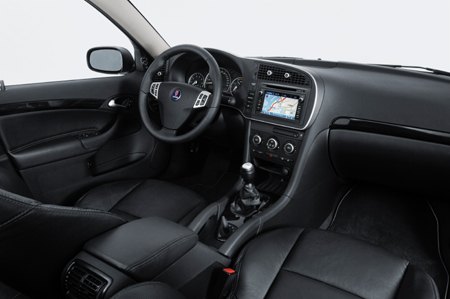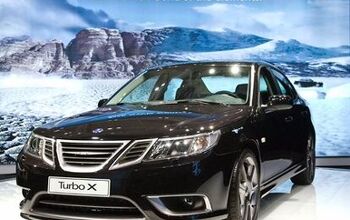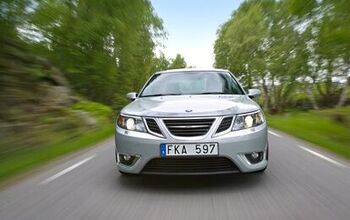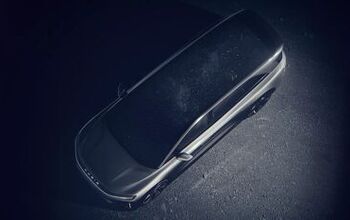Review: Saab 9-3 Turbo X
Volvo did it. Acura still does it. Audi has been doing it for a long time. And now Saab is giving it a shot: start with a front-wheel-drive platform, add a powerful engine and an all-wheel-drive system (hopefully with a few tricks up its sleeve), and then try to pass the nose-heavy result off as a viable alternative to a balanced rear-wheel-drive BMW. To wit: the limited edition 2008 Saab 9-3 Turbo X, in sedan or wagon SportCombi form. Success? Not so much.
Imagine a Saab 9-3 with a coat of black metallic paint, prominent stylized dual exhaust tips and 18” alloys that recall the tri-spoke rims that distinguished the brand’s iconic 900 SPG. That’s the Turbo X. The 9-3 has never been distinctive enough to be interesting or beautiful enough to be, well, beautiful. At best, these tweaks render it mildly sinister.
The Turbo X cabin is much the same as the regular 9-3 Aero, with solid black instead of two-tone leather and faux carbon fiber trim. The interior looks and feels like that of a $30k car, at best; the Turbo X’s price is 50 percent north of that mark. Interior low points: the hard plastic door pulls crunch when you grab them and various plastic-on-plastic itches when traversing pocked pavement. Interior high point: the soft leather upholstery.
The Turbo X’s front seats may not be Sweden’s best, but they provide a decent amount of lateral support. In back, you’ll find barely enough room for adults. Cargo volume is about average; the tailgate latch was fussy on the car tested.
The mechanicals: a 280-horsepower turbocharged 2.8-liter DOHC V6 driving four wheels through a six-speed manual (paddle-shifted six-speed auto optional) and the latest Haldex all-wheel-drive system (which doesn’t wait for the front wheels to slip before engaging the rears). The Turbo X adds an electronic limited-slip rear that distributes torque left-to-right to counteract understeer in turns.
Boost lag isn’t bad. From 3,000 to 5,000 rpm, the turbo six’s smooth, effortless grunt would do a V8 proud. Rev the engine before releasing the clutch, and the car launches strongly and— thanks to the all-wheel-drive system— without wheelspin. While the Turbo X is not blindingly quick, you’re soon up to cruising speed. Even at full throttle, the DOHC mechanicals barely manage to be heard over the prominently throaty exhaust. While cruising, the soundtrack is all exhaust, whether you want it or not. After a few hours on the road, not.
The Turbo X’s shifter is awful. The throws are long, the action dreadfully imprecise. There’s easily enough room between first and second for another ratio. Unless you rev the engine nearly to the redline, the powerplant drops out of its powerband. And even if you do rev to red, the powertrain bogs as you engage second. Meanwhile, fourth, fifth, and sixth are so close together that one of them is redundant. And yet the stick is still preferable to the Aisin autobox.
The suspension absorbs bumps reasonably well. Yet the occasional jolt suggests hardcore suspension tuning… until you pitch the Turbo X hard into a turn. Then the Swedish flagship heels over and the outside front tire scrubs towards the outside curb. Despite the trick all-wheel-drive system, the Turbo X’s general inclination is toward understeer. Numb, slow steering operated via an oversized (but nicely padded) steering wheel doesn’t help.
So, any potential for some sideways hoonage? The initial prognosis was not good. Despite repeated attempts to induce oversteer, the Turbo X continued to plow. But then I found it: dip deep into the throttle during low-speed sharp turns, preferably on gravel, and the tail will step out, sometimes more than you’d like it to. At which point the stability control doesn’t seem to do much. No matter, the car remains easy to control, and a touch of opposite lock straightens up the X’s line.
While occasional throttle-induced oversteer makes for more fun than none at all, the trick all-wheel-drive system and suspension need to be retuned to shift from understeer to oversteer in a more linear fashion. In a good rear-wheel-drive car, you can progressively dial-in a precise amount of oversteer. In the Saab, you get dull understeer unless you do the sort of things you’re just not going to do in normal driving. Perhaps there’s just no substitute for an inherently balanced, rear-drive chassis.
Saab desperately needs a great car, one that provides the sort of unique driving experience that gave the brand a brief golden age in the mid-1980s. Sadly, the 9-3 Turbo X isn’t it. Saab’s engineers lacked either the nerve or the authority to push this car as far as it needed to go. As a result, the Turbo X will please neither those seeking luxury nor those seeking an engaging driving experience.
[Saab provided the vehicle reviewed, insurance and a tank of gas]
Michael Karesh lives in West Bloomfield, Michigan, with his wife and three children. In 2003 he received a Ph.D. from the University of Chicago. While in Chicago he worked at the National Opinion Research Center, a leader in the field of survey research. For his doctoral thesis, he spent a year-and-a-half inside an automaker studying how and how well it understood consumers when developing new products. While pursuing the degree he taught consumer behavior and product development at Oakland University. Since 1999, he has contributed auto reviews to Epinions, where he is currently one of two people in charge of the autos section. Since earning the degree he has continued to care for his children (school, gymnastics, tae-kwan-do...) and write reviews for Epinions and, more recently, The Truth About Cars while developing TrueDelta, a vehicle reliability and price comparison site.
More by Michael Karesh
Latest Car Reviews
Read moreLatest Product Reviews
Read moreRecent Comments
- Theflyersfan OK, I'm going to stretch the words "positive change" to the breaking point here, but there might be some positive change going on with the beaver grille here. This picture was at Car and Driver. You'll notice that the grille now dives into a larger lower air intake instead of really standing out in a sea of plastic. In darker colors like this blue, it somewhat conceals the absolute obscene amount of real estate this unneeded monstrosity of a failed styling attempt takes up. The Euro front plate might be hiding some sins as well. You be the judge.
- Theflyersfan I know given the body style they'll sell dozens, but for those of us who grew up wanting a nice Prelude Si with 4WS but our student budgets said no way, it'd be interesting to see if Honda can persuade GenX-ers to open their wallets for one. Civic Type-R powertrain in a coupe body style? Mild hybrid if they have to? The holy grail will still be if Honda gives the ultimate middle finger towards all things EV and hybrid, hides a few engineers in the basement away from spy cameras and leaks, comes up with a limited run of 9,000 rpm engines and gives us the last gasp of the S2000 once again. A send off to remind us of when once they screamed before everything sounds like a whirring appliance.
- Jeff Nice concept car. One can only dream.
- Funky D The problem is not exclusively the cost of the vehicle. The problem is that there are too few use cases for BEVs that couldn't be done by a plug-in hybrid, with the latter having the ability to do long-range trips without requiring lengthy recharging and being better able to function in really cold climates.In our particular case, a plug-in hybrid would run in all electric mode for the vast majority of the miles we would drive on a regular basis. It would also charge faster and the battery replacement should be less expensive than its BEV counterpart.So the answer for me is a polite, but firm NO.
- 3SpeedAutomatic 2012 Ford Escape V6 FWD at 147k miles:Just went thru a heavy maintenance cycle: full brake job with rotors and drums, replace top & bottom radiator hoses, radiator flush, transmission flush, replace valve cover gaskets (still leaks oil, but not as bad as before), & fan belt. Also, #4 fuel injector locked up. About $4.5k spread over 19 months. Sole means of transportation, so don't mind spending the money for reliability. Was going to replace prior to the above maintenance cycle, but COVID screwed up the market ( $4k markup over sticker including $400 for nitrogen in the tires), so bit the bullet. Now serious about replacing, but waiting for used and/or new car prices to fall a bit more. Have my eye on a particular SUV. Last I checked, had a $2.5k discount with great interest rate (better than my CU) for financing. Will keep on driving Escape as long as A/C works. 🚗🚗🚗






































Comments
Join the conversation
This article makes me sick ... Beemers shouldn't right on other brand to destroy a good car ... WTF ??? for the 1 to 2 gearing ??? Well ... who can be as proud as Saab for load of low en torque ??? what's the point of shiftin 5000rpm when you have all the torque @ 2000 ??? Why use 1 and 2 close when you can pass by any other cars while other need to shift ??? This gearing has been made to have constant performance whatever speed (shorter at high speed, longer at low speed) to take advantage of all the torque of saab .... That guy is a wanna be, the site is close to it ... Reliability ??? Fuck ! change you fuking oil guy !!! I've had 7 saabs (5 turbo charged) high mileage, track and teaching with it, never had gasket or reliability problem ... but all the best oil and changed @ 5/6000km MAX The saab X received a pretty good and modern XWD ... well after 20 or 30 year teaching all other car makers on car technology ... it's pretty cheap payd ... just a XWD ... On many way, saab had advance on honda, subaru, mercedes, Bmw, whatever american, volvo and more. not just 6 month but years in advance !!! on turbo charging, X safty brake lines, ACC, heated seats, ventilated seats, lights wipers, passive security, active security, shit load of low end torque (especially for 4 cyl 16v !!!) ... in 1993 Saab had the same torque with a 4cyl as a 2008 Acura V6, 3000 rpm lower ...
Well, I am a bit late to the party here but I am going to leave my two cents. All of the Saab bashing here is pathetic. This was an extremely poor review for a great car. I have two Saabs and plan on buying a third soon. My 9-3 has 178000 miles on it and drives like a dream. No issues other than normal wear and tear. Saab is expensive because they are built to withstand nearly anything. When someone crashes a Saab, the impact of whatever it hits is spread out along the car..to absorb impact better and to minimize damage and injury.The engine is designed to slide under the car instead of crashing into the passenger area. EVERYTHING is about protecting the passenger cell. That information comes directly from men who built this car in Sweden! Go google the youtube video showing a Saab and a BMW being dropped upside down from 8ft. The BMW smashes as flat as a pancake. You would have been able to push the door and exit the Saab. So, my guess is all of these bashers have never even so much as SAT in a Saab..and that includes the author of this poorly written review.